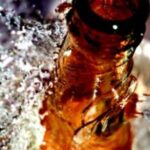Seahorses (Syngnathidae) are classified as bony fish (Michael, 154). Thirty-three species of seahorses exist. When a seahorse swims, it moves itself forward slowly with its body vertical. The fish are distributed in the Eastern Atlantic from Great Britain to Morocco, Africa and the Mediterranean. Seahorses can be found living in shallow waters among algae (Beer, 117). A seahorse that is bright and colorful is usually in a colorful habitat.
Males and females change color to attract each other. The male is slimmer and less spiny. Mating habits often affect a seahorse’s color. When a male and female seahorse mate, they perform a dance with their tails linked together. Following that, they face each other with their bellies together. The female transfers eggs to the male’s brood pouch to be fertilized. After ten to twenty-one days, the male seahorse gives birth to live young that resemble both parents (Tackett, 191). Some species have a reproductive period that lasts over eight months and varies with temperature. Some species in Brazil reproduce year-round.
Seahorses eat larva fish, crustaceans, and plankton. The creature does not have any teeth, so it swallows its food whole through its snout. Since seahorses don’t have stomachs, they tend to eat throughout the day. The Pygmy Seahorse (Hippocampus bargibanti) lives on its host, which is the sea fan. This species of seahorse is only 2 cm tall and resembles its host (Tackett, 168). The adult seahorse has very few predators, like crabs. Since crabs and seahorses share the same habitat, crabs can become aggressive towards seahorses. The reason that seahorses have few predators is because of their ability to camouflage themselves and hide among weed.
As of June 1, 2004, seahorses became an endangered species. Reefs and mangroves are the most threatened habitats in the world. Pregnant males are vulnerable to over fishing due to their long parental care (McGavin, 158). The Asian folk-medicine trade is largely responsible for the extirpation of many species. Approximately 24 million seahorses are dried for use in medicines to treat skin irritations, heart disease, and broken bones (McGavin, 46). Although there are not any scientific studies to support the effectiveness of these folk medicines, people believe that they work. Larger seahorses are increasing in demand as the human population grows.
Seahorses are also traded as aquarium pets and ornaments. The longsnout seahorse is the preferred species for this purpose. Colorful seahorses have more monetary value than black ones. Black seahorses lack pigmentation. Seahorses are a source of income for many fishing communities in developing countries. Seahorse populations have declined over the years due to habitat degradation and exploitation. In addition, they are easier to catch than most fish and have high economic value.
Earlier this year, the University of Rhode Island-Graduate School of Oceanography restored eelgrass plants in Narragansett Bay with funding through Natural Resources Conservation Services (NRCS). An eelgrass seeding machine sowed innumerable seeds under water. Seeds were injected in a nutritive, jellylike matrix and injected just below the sediment surface. Eelgrass is an under water marine flowering plant that provides important environmental sources to bays and coasts worldwide. Eelgrass areas are a primary source of food and shelter for many types of marine life, such as the bay scallop. The underwater vegetation also prevents shoreline erosion. Since the eelgrass has been restored, many sea creatures like flounder, crabs, and seahorses, abide there (“Save the Bay”, n.d.).
In 2005, boat captains mow underwater sea grass beds in the Chesapeake Bay in Crisfield, Maryland. The goal was to distribute seeds in barren areas of the bay. During the previous year, millions of sea grass seeds were tossed into the bay covering about 100 acres. These planting technique projects in Maryland and Virginia cost a total of $500,000 over a three-year period. Lush underwater sea grass beds attract young fish and crabs while supplying the water with oxygen. Crabs, seahorses, and turtles are found in abundance (Bergstrom, 1).
Hong Kong strictly regulates the import, export, and possession of endangered species of all types under the Animals and Plants (Protection of Endangered Species) Ordinance. As of June 1, 2004, seahorses are protected under the ordinance along with other freshwater and marine life (Yuen, 13).
References
- Beer, Amy-Jane and Hall, Derek. (2007) Marine Fish and Sea Creatures. London: Anness Publishing Ltd.
- Bergstrom, Peter. (July-August 2005) Building a Better Grass Bed. Bay Journal.
- McGavin, George C. (2006) Endangered: Wildlife on the Brink of Extinction. Buffalo: Firefly Books.
- Michael, Scott W. (2008) The 101 Best: Saltwater Fishes. Neptune City: T.F.H. Publications, Inc.
- Tackett, Denise Nielson. (2002) Reef Life: Natural History and Behaviors of Marine Fishes and Invertebrates. Neptune City: T.F.H. Publications, Inc.
- Yuen, Caroline. (July 31, 2005). Hong Kong Food and Agricultural Impact Regulations and Standards County Report 2005. Retrieved November 2, 2008 from http://www.fas.usda.gov.
- NRCS Partners With Save the Bay and the University of Rhode Island to Restore Eelgrass Habitats. (March 17, 2008). Retrieved November 1, 2008 from http://www.ri.nrcs.usda.gov.





